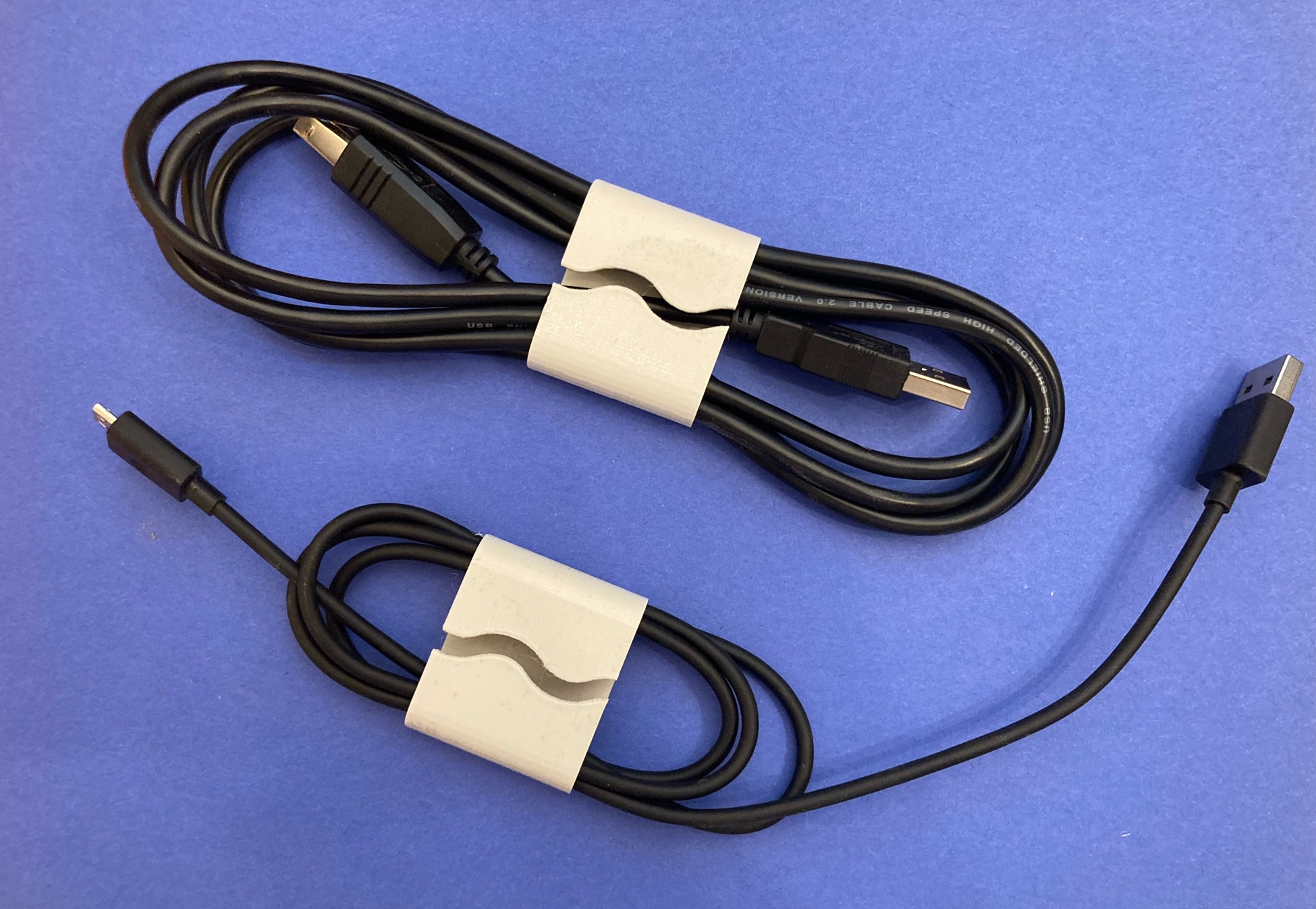
Cable clinger
prusaprinters
<p>My desk was dominated by loose USB cables going to devboards. Trying to use velcro to bundle them left them floppy, and the cables stuck to each other and it was generally a bad scene. It was also hard to quickly extend the cables.</p><p>So I designed this thing real quick. You can use this both for storage and for cable management. The OpenSCAD file can be used with the customizer for any cable you might want to bundle with it.</p><p>For cable management, you can coil up your cord, feed it through, and then pull segments in and out as needed. The bundle is kept in a definite shape, without any floppiness: cords in these feel oddly solid, since they don't wiggle like you're used to.</p><p>For storage, if you're careful how you wind things up, you can slip the cable ends <strong>inside</strong> the loops of the cord. This results in a very compact, contained cable, ideal for storage. I'm going to be using overnight idle time on my printer to crank these out, as I have a lot of cables, and these make a huge difference in how easy they are to manage in storage. I believe these take up roughly a third of the volume of a normal, round-looped cord.</p><p>The flat side is actually slightly domed the inside, which makes it quite rigid.</p><p>The wavy pattern makes it possible to get strands in and out of the clinger without unbundling things, but makes it very difficult for cords to come out accidentally.</p><p>A FreeCAD file of the STL here is included: FreeCAD allows for some nice edge contours on the wave cutout. All the key dimensions are in a spreadsheet, if you want to change them, though the wave pattern will probably need to be touched up a bunch.</p><p>I wanted one of these for a power cord, so I slapped together an OpenSCAD version with customizer support. You'll find that here as well. The FreeCAD one is a bit nicer, but the OpenSCAD one is fully parametric in a friendlier fashion.</p><p>Anyway, I'm very happy with these, and hope they are useful or inspiring to someone else.</p><p> </p><h4><strong>OpenSCAD Parameters</strong></h4><p>The OpenSCAD version is fully parametric, and works from first principles. You give it the diameter of your wire, and how many loops to fit in, and it does circle packing to find the minimum diameter. It also has a minimum bend radius parameter, so you can store your cables as tightly as is safe for them (6 is probably good for most small copper wires, and 20 is recommended for TOSLINK fiber optics). There's also a bunch of comments in there, if you want to tweak the design.</p><p>If you want to run off a bunch of customized OpenSCAD parts, they print reliably on my crappy printer with a small brim. You will want to run one off first, though, and make sure the combination of cord springiness and wall thickness works well. For stiffer cables, you will want thicker walls, but keeping them thin is important in terms of efficiency (if you're making dozens of them).</p><p>You may want to crank up $fn from its default value, or PrusaSlicer may try to add unneeded gap fills in the circles. </p><p>But, mostly, you just need to measure your cables roughly, and plug stuff in. Here are some common cable diameters that I've found:</p><figure class="table"><table><tbody><tr><td>Cable Type</td><td>Diameter </td><td>Notes</td></tr><tr><td>USB</td><td>3.75 </td><td>Most USB cables are about this diameter</td></tr><tr><td>Cloth USB</td><td>5</td><td>Fancypants USB cables tend to be thicker.<br>They probably work at 3.75, but this is safe</td></tr><tr><td>USB 3</td><td>7</td><td>Not recommended! Fiddly little cables, bend ratio >10.<br>Wall thickness of 1.6mm (0.4mm extrusion) or 1.8mm.</td></tr><tr><td> </td><td> </td><td> </td></tr><tr><td>Ethernet</td><td>5</td><td>Pretty typical, you probably want to increase the bend ratio to 8x</td></tr><tr><td> </td><td> </td><td> </td></tr><tr><td>Laptop AC</td><td>7.5</td><td>This is a rough average based on the cords in my house</td></tr><tr><td> </td><td> </td><td> </td></tr><tr><td>Oscilloscope probe</td><td>3.25</td><td>I'd definitely increase the bend ratio to 10x or more on these!</td></tr><tr><td>Banana cables</td><td>4</td><td>Varies depending on quality/price</td></tr><tr><td> </td><td> </td><td> </td></tr><tr><td>Headphones (thick)</td><td>4</td><td>On a nice set of over-ear headphones</td></tr><tr><td>Earbuds (thin)</td><td>2</td><td>Probably better to use a dedicated earbud holder, though</td></tr><tr><td> </td><td> </td><td> </td></tr><tr><td>HDMI</td><td>6</td><td>Not recommended! Bend ratio >12.</td></tr></tbody></table></figure><p> </p><p>If you use this and find a different diameter for your uses, please post them in the comments!</p><p> </p><h4><strong>Related prints</strong></h4><p>While looking at the collections you all put this in, I found a very similar concept from a bit earlier. It's not as beautiful, but it seems like it's going to be just as effective, and, most importantly, print a lot faster than my design: <a href="https://www.prusaprinters.org/prints/51170-cable-clip-for-usb-cables/comments">https://www.prusaprinters.org/prints/51170-cable-clip-for-usb-cables/</a></p><p>If you like the idea of this, but are looking for something faster, that one may be what you're looking for.</p>
With this file you will be able to print Cable clinger with your 3D printer. Click on the button and save the file on your computer to work, edit or customize your design. You can also find more 3D designs for printers on Cable clinger.
